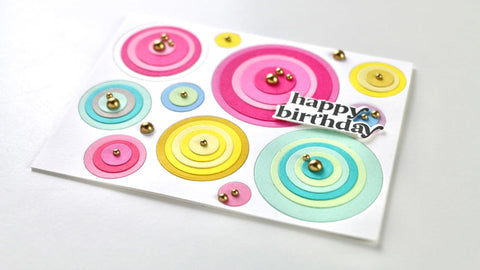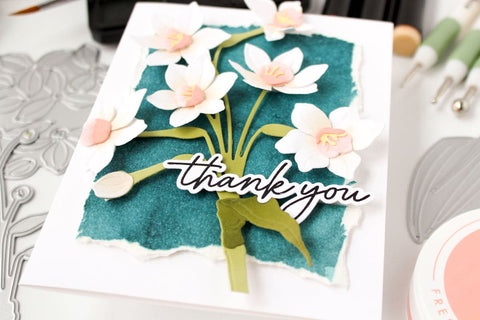10 Clean and Minimalistic Card Design Ideas to Try
Last Updated: July 1, 2025
Are you ever caught in the middle of crafting the perfect card, only to find yourself wrestling with the age-old challenge of utilizing white space effectively? We've all been there - wanting to try all the techniques on one card - only to end up with so many elements! While creating complex cards features a unique result and involves a fun process, sometimes, using fewer elements can create more captivating designs.

If you've ever wanted to get more tips on how to use white space in your design, fret not because, in today's blog post, we're diving headfirst into it! We will discuss ten different techniques for clean and simple cards, unravel the mysteries of white space, and explore how to use them to your advantage. After reading this post, your inspiration for composition and layouts will grow! So get your crafting game on, and let's go!
1. Play Around With Half Proportions
Imagine this: you've got a blank card in front of you, and you're pondering how to infuse it with that clean and minimalistic charm. Well, here's a nifty trick – why not play around with half proportions? It's as simple as it sounds – just use half of the space on your card for your design elements.

You can do a horizontal cut, a vertical cut, or a top and bottom half cut - the choice is yours! By intentionally leaving half of the card empty, you're letting the power of white space work its magic. This technique instantly gives your design a breath of fresh air, making it visually appealing and uncluttered. Whether you're crafting a birthday card, a thank-you note, or even an invitation, this approach can make your message stand out like never before!
2. Let a Large Word or Sentiment Die Steal the Spotlight
With this technique, you use your favorite sentiment die-cut - preferably a large one and make it your focal point against a plain background. By keeping the background simple and uncluttered, your word or sentiment die becomes the star of the show.

If you wanna replicate Therese's design above, as an added finishing touch, use some small elements like flowers to accent the large letters.
3. Use Tone-On-Tone Elements
Wanna know the secret to being able to use multiple designs and textures but still end up with a clean and classy look? Tone-on-tone colors are the key! Tone-on-tone means using different shades of the same color family. So, for example, if your card is blue, you might want to use contrasting colors normally, but with tone-on-tone, we use similar shades of blue to create that "clean and simple effect" without sacrificing the number of techniques you want to do!

4. Backgrounds With Thin Sketches and Outlines
Do you have outline stamps? Now's the perfect time to use them! If you have mini stamps or stamps that produce thin lines, you can use them to create simple yet stunning backgrounds for your cards easily.

5. Create Spacious Arrangements
We all know the allure of filling up our cards, but if you want your recipient's eyes to be drawn toward a specific element or sentiment, it's time for spacious arrangements! You can do this technique by choosing less instead of more, such as choosing a single-stemmed flower to be stamped along one side instead of an entire floral bouquet on your panel. The key is to give each element ample space to breathe.

Build-A-Flower: Coneflower Layering Stamp & Die Set
6. Inky Embossed or Debossed Images
Want a quick, easy, yet elegant-looking card? Try embossed or debossed images highlighted with neutral colors! This creates a soothing accent that draws the eye without overwhelming it. Neutral and pastel colors you can use include whites, creams, grays, soft browns, and light shades that don't scream for attention but rather offer a serene backdrop for other elements to shine.

Craft Your Life Project Kit: Hello Beautiful
7. Frame Your Elements in the Middle
When you're working on a card design, one effective technique is to place your key elements right in the middle of your canvas. By positioning your main elements centrally, you create a visual focal point that naturally draws the viewer's eye.

From there, you can easily add surrounding accents around it to highlight the center even more. This approach keeps things neat and organized, giving your design a clean and balanced look!
8. Make Your Design Elements Equal
By making your elements equal, we mean pairing them with the same type of design. For example, if you have an outline die, pair it with an outline stamp set. If you use a geometric background, pair it with a sentiment with a modern or sharp-looking font! Instead of the usual contrast that you do, this technique helps give your cards a unique harmony, resulting in one-of-a-kind, simple layouts.

9. Spotlight Coloring
This approach involves strategically using color to draw attention to a specific element on your card while keeping the rest of the design in black and white. Imagine a classic black-and-white movie with a single object in color – that's the effect we're going for!

Whether it's a vibrant flower, a whimsical balloon, or a heartfelt sentiment, this technique adds an element of surprise and intrigue to your card. Not only does it eliminate the struggle of managing white space, but it also simplifies your design process by focusing on just one standout feature.
10. Experiment With Muted Colors

Trailblazing Fresh Dye Ink Bundle
When it comes to creating cards that are clean and minimalistic, one effective technique is to play around with muted colors. Muted colors are those shades that have been toned down, giving them a softer and less vibrant appearance. These colors can bring a sense of understated elegance to your cards. Remember, the goal here is to let the colors work harmoniously with the surrounding white space, contributing to an overall clean and uncluttered feel.
Conquer the Challenges of Using White Space With These Tips!
Overall, embracing clean and minimalistic card design doesn't have to be an intimidating journey. With a keen eye for using white space and a willingness to experiment, you can craft cards that exude elegance and simplicity!
So go ahead and explore using muted colors, experiment with balanced compositions, and let the spaces between your design elements weave their own stories. If you want more inspiration and tips like these, there are always more beautiful designs to see at the Altenew Blog ! We can't wait to see your creations - happy crafting!
2 comments
In This Article
More Crafty Reads & Inspirations
-

Starting 2026 With a Clean Slate and Using Up Leftovers
-

January 2026 Inspiration Challenge
-

Simple Tips To Bring Your Die Cut Florals To Life - A Touch of Sparkle With Carissa Wiley
-

3 Secrets for No-Outline Watercoloring: The Art of the Disappearing Line | Perfect Pairings with Jaycee
-

Card Ideas that Symbolize New Beginnings
















Thank you, Louise! We are glad you enjoyed the post :) Can’t wait to see your minimalistic cards!
Love this mini tutorial, thank you.